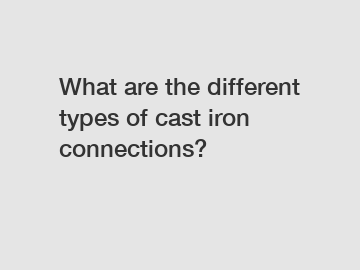What are the different types of cast iron connections?
What are the different types of cast iron connections?
Cast iron, a popular material used in the construction industry, offers various types of connections, each serving a specific purpose. The different types of cast iron connections include flange connections, mechanical connections, jointing connections, and spigot and socket connections. These connections serve as essential components in ensuring structural stability and efficiency in various applications.
Flange connections are commonly used in cast iron pipes and fittings, where two components are joined by a flange and bolted together. This type of connection provides a secure and efficient way to connect pipes, allowing for easy assembly and disassembly when required. Flange connections also offer flexibility as they can be used in different pipe sizes and materials.

Mechanical connections, on the other hand, utilize mechanical means to secure the joint. These connections include push-on joints, mechanical joint glands, and gasketed joints. The push-on joint connection is relatively simple, where a rubber gasket is used to create a tight seal between pipes. Mechanical joint glands consist of a gland follower, a gland, and bolts, which ensure a secure connection. Gasketed joints utilize a rubber gasket to provide a leak-tight and flexible connection.
Jointing connections involve the use of materials or compounds to create a seal between two components. These connections include bell and spigot joints, lead and oakum joints, and caulked joints. Bell and spigot joints utilize a rubber ring or gasket to provide a watertight seal, commonly used in sewer and drainage systems. Lead and oakum joints involve packing a combination of lead and oakum fibers into a joint to create a watertight seal. Caulked joints use a mixture of caulking material, such as putty or lead, to provide a leakproof connection.
Spigot and socket connections are primarily used in pipes and fittings, where a spigot end is inserted into a socket end, creating a secure and leak-resistant joint. This connection allows for easy assembly and disassembly and ensures a tight seal.
The significance of understanding the different types of cast iron connections lies in their influence on the overall efficiency and longevity of a structure. Choosing the appropriate connection type for a specific application is crucial in ensuring structural integrity, minimizing the risk of leaks, and improving the overall performance of the system.
Moreover, the type of cast iron connection can impact the maintenance and repair processes. For instance, flange connections provide easy access for inspection and maintenance, allowing for quick repairs or replacements if necessary. On the other hand, jointing connections may require specialized skills or equipment for repairs, depending on the specific type of joint.
In conclusion, cast iron connections play a vital role in the construction industry, offering various types to meet different requirements. Understanding the different types of connections, their applications, and their advantages helps ensure the selection of the most suitable connection for a given project. This knowledge improves the structural stability, efficiency, and longevity of the system, ultimately contributing to the success of the construction project.
Contact us to discuss your requirements of China bellows gate valve manufacturer, China 2pc cast steel ball valve manufacturer, China cast iron din stop check valve supplier. Our experienced sales team can help you identify the options that best suit your needs.

Comments